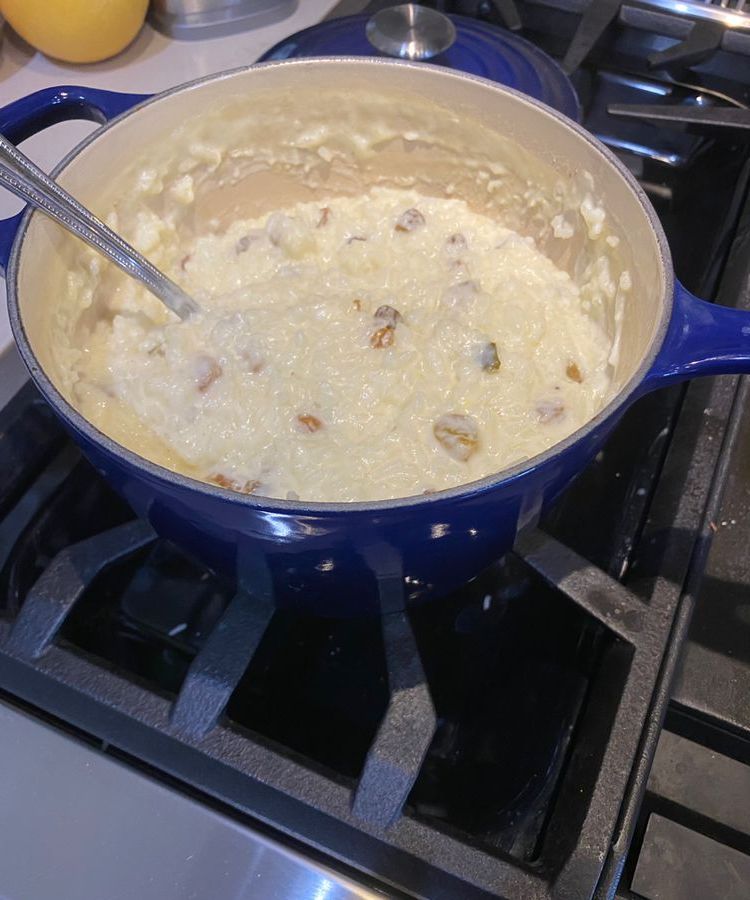The combination of creaminess and flavor in this rice pudding dish makes my heart happy. The extra effort is well worth it, despite the fact that it may appear laborious at first. To me, this is the definition of comfort food, therefore it has to be perfect.
This pudding recipe is fantastic since it requires constant monitoring of the pudding’s progress as it cooks, including temperature, consistency, and texture. I like having a hand in making crucial decisions like how much liquid to use, how long to cook the rice, and how hot the stove should be. I wonder whether it’s just me.
I’m aware that the inclusion of raisins in rice pudding can spark heated debate; having seen firsthand how this can divide families, I can attest to the fact that arguments over this topic are never pleasant. You can prepare it in any way you like; I won’t criticize you! Alternatively, you might cook half of the pudding with raisins and the other half without. This helps maintain harmony in my home, where opinions on the raisin dispute run deep. Who knew a simple disagreement about raisins could lead to such vehement counterarguments!
INGREDIENTS
Full-fat milk, at least 4 cups (more if possible)
Half a cup of uncooked, medium-grain white rice
Two-thirds of a cup of whipped cream that is extra-heavy and thick
Approximately a third of a cup of white sugar
An Eighth of a Teaspoon of Salt
About 2 whole egg yolks
1/2 teaspoon salt 1 tablespoon butter
1 1/2 teaspoons of vanilla extract
1/2 cup dried cranberries (golden or ordinary) – Variable

Instructions:
Drain the contents of a big saucepan and rinse it with cold water. Hold off on the dryer.
Put on a stove top over moderate heat. Blend in some milk.
Over medium heat, while stirring often, bring the milk to a rolling boil. HOLD YOUR BREATH as the water begins to boil! The situation might swiftly escalate and you must prevent a boilover at all costs.
While the milk is still boiling, add the rice and stir constantly until the mixture returns to a boil.
Turn the heat down to just just above low, or to the lowest setting that will produce a gentle simmer in your pot (bubbles breaking the surface but not too vigorously).
Bring to a simmer and maintain at that temperature for 30 minutes, stirring down every 5-10 minutes. (Make sure the rice doesn’t stick to the bottom of the pan by stirring it down often.)
A skin will form on top of the mixture as it sits. Never take it out of the picture. Basically, you should just mix it back in.
In a medium bowl, whisk together the heavy cream, sugar, egg yolks, vanilla extract, and salt while the rice is boiling. To thoroughly combine ingredients, whisk them together. Put aside, but don’t put in the fridge.
After 30 minutes, the rice should continue boiling with frequent stirring down. Be sure to check on the rice every few minutes to ensure it cooks to a perfect tenderness (no hard center).
Note that the rice you used may cause the mixture to thicken up at this point, leaving you with very little milky liquid. In this case, add a small amount of hot milk to the rice while you stir, just enough to get the ingredients moving again. If you let the mixture become too dry, it will burn, so keep a constant eye on it.
Keep going until the rice is tender, checking it occasionally and adding more milk if necessary by stirring it down. On average, rice just needs 45-50 minutes of simmering time until it’s done. Since several variables impact the total time, there is no one universal standard. The best gauge is the sense of taste.
As soon as the rice is done cooking, take the saucepan from the heat.
The eggs should be whisked once more. Take roughly 1 cup of the rice/hot liquid mixture and transfer it to a glass measuring cup or a ladle.
Using a measuring cup or a ladle, gradually add the rice mixture to the egg mixture while whisking rapidly with the other hand. Stir the egg around repeatedly while doing this to prevent it from cooking. When the rice and liquid are well blended, measure out another cup of the hot liquid and continue the process.
After that, you can add the egg mixture to the pot. Combine ingredients by stirring.
Cook on low heat with the pot. Keep swirling until a bubble the size of a dime appears on the surface of the pudding. The pudding will start to thicken, but it will still have some sauce in it. The pudding will finish setting in the refrigerator.
To thicken a liquid to the consistency of heavy cream, boil it for a few minutes longer while stirring constantly if it appears thin, like milk. If you let the pudding come to a boil, the eggs will scramble, so keep the heat moderate.
Put the raisins in a big bowl if you’re planning on using them.
Pudding is ready when the mixture can be stirred and a knife inserted into the center comes out clean.
To blend, stir vigorously. To limit the amount of steam, wait about 5 minutes before covering the bowl with plastic wrap and putting it in the fridge.
Set aside for at least 6 hours to cool and harden (preferably over-night).
Toss before serving. You can warm your rice pudding gently in the microwave or a small saucepan if you prefer it that way. To thin out pudding that’s overly thick, add a tablespoon or so of heavy cream and stir until smooth.

